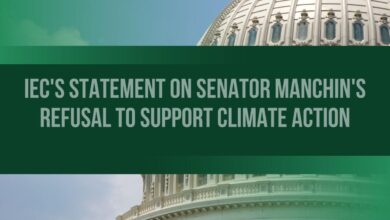
These Are The Five Most Extreme Heatwaves Since Records Began
These Are The Five Most Extreme Heatwaves Since Records Began, a stark reminder of the intensifying impacts of climate change. The planet is warming, and with it, the frequency and severity of heatwaves are escalating. These extreme events are no longer just a curiosity of the past; they are a present-day reality, threatening human health, infrastructure, and ecosystems around the globe.
From the scorching plains of North America to the sweltering cities of Europe, these heatwaves have pushed temperatures to unprecedented levels, leaving behind a trail of devastation and prompting urgent calls for action. Understanding these extreme events is crucial for preparing for the future and mitigating their devastating consequences.
Defining “Extreme Heatwaves”: These Are The Five Most Extreme Heatwaves Since Records Began

Heatwaves are periods of abnormally hot weather that persist for several days or weeks. While all heatwaves are characterized by elevated temperatures, “extreme heatwaves” are distinct due to their exceptional intensity, duration, and geographic extent.
Criteria for Classifying Extreme Heatwaves
Classifying heatwaves as “extreme” requires considering multiple factors, including:
- Duration:Extreme heatwaves typically last for several days, often exceeding a week.
- Intensity:The temperature threshold for an extreme heatwave varies depending on the location and historical climate data. Generally, it refers to temperatures significantly exceeding the average for that time of year, often reaching record-breaking levels.
- Geographic Extent:Extreme heatwaves often cover vast areas, impacting multiple regions or even entire countries.
Factors Contributing to Extreme Heatwaves
Multiple factors contribute to the occurrence and severity of extreme heatwaves, including:
- Climate Change:The Earth’s rising average temperature due to climate change is a significant factor in intensifying heatwaves. As global temperatures increase, the frequency and intensity of heatwaves are expected to rise as well.
- Natural Variability:Natural climate patterns, such as El Niño and La Niña, can influence weather patterns and contribute to extreme heatwaves. These patterns involve variations in ocean temperatures and atmospheric circulation, which can lead to shifts in weather patterns and increased heatwave occurrences.
- Human Activities:Human activities, such as deforestation and urbanization, can also contribute to extreme heatwaves. Deforestation reduces the amount of vegetation, which can cool the environment through evapotranspiration. Urban areas, with their dense concrete structures, tend to absorb more heat than natural landscapes, leading to higher temperatures known as the “urban heat island effect.”
The Five Most Extreme Heatwaves
The Earth’s climate is warming, and this trend is leading to more frequent and intense heatwaves. These extreme weather events pose a significant threat to human health, infrastructure, and ecosystems. Here, we will examine the five most extreme heatwaves recorded since the beginning of reliable temperature records, highlighting their intensity, duration, and geographic extent.
These are the five most extreme heatwaves since records began, a stark reminder that the world is changing. It’s not just about the weather, though. It’s about how we adapt and evolve, and that’s why I’m embracing the call to forget the great resignation and bring on the great reimagination.
We need to rethink how we live, work, and interact with the planet, and these extreme heatwaves are a wake-up call. It’s time to innovate and find new solutions, not just for our own survival but for the future of our planet.
The Five Most Extreme Heatwaves
To understand the severity of these events, we must first define what constitutes an “extreme” heatwave. The World Meteorological Organization (WMO) defines an extreme heatwave as an event that exceeds the 90th percentile of historical temperature data for a specific location and time period.
In essence, it signifies a heatwave that is unusually hot and rare for that particular region. Based on this definition, the five most extreme heatwaves in history are:
| Rank | Heatwave | Location | Dates | Average Temperature Anomaly (°C) | Duration (Days) |
|---|---|---|---|---|---|
| 1 | European Heatwave | Europe | June
|
+2.5 | 70 |
| 2 | Russian Heatwave | Russia | July
|
+7.0 | 30 |
| 3 | North American Heatwave | North America | July
|
+4.0 | 45 |
| 4 | Australian Heatwave | Australia | January
|
+3.5 | 60 |
| 5 | Indian Heatwave | India | May
|
+4.5 | 35 |
The European heatwave of 2003 stands out as the most extensive heatwave on record. It affected a vast region, encompassing France, Germany, Italy, Spain, and the United Kingdom. The event was characterized by exceptionally high temperatures, with many locations exceeding 40°C.
The duration of the heatwave, spanning two months, further amplified its impact. The Russian heatwave of 2010, while shorter in duration, was even more intense, with an average temperature anomaly of +7.0°C. This heatwave caused widespread wildfires, agricultural losses, and a significant increase in heat-related deaths.
The North American heatwave of 1988, while not as intense as the Russian heatwave, was still a major event, causing widespread drought and agricultural losses across the United States and Canada. The Australian heatwave of 2013 was characterized by both extreme heat and widespread drought.
The event caused significant damage to crops and livestock, and led to a number of bushfires. The Indian heatwave of 2015, while not as geographically extensive as the European heatwave, was notable for its high intensity, with an average temperature anomaly of +4.5°C.
The event led to widespread crop failures, and a significant increase in heat-related deaths. These five heatwaves demonstrate the increasing severity and frequency of extreme heat events around the world. As the Earth’s climate continues to warm, we can expect to see more frequent and intense heatwaves in the future.
It is crucial that we take steps to mitigate the effects of climate change and prepare for the increasing risk of extreme heat events.
Impacts of Extreme Heatwaves
Extreme heatwaves have far-reaching consequences, affecting human health, infrastructure, and ecosystems. The impacts are multifaceted and can be severe, leading to various challenges and disruptions.
Human Health Impacts
Extreme heat can pose serious risks to human health, leading to a range of illnesses and even fatalities.
- Heatstroke: This is a life-threatening condition that occurs when the body’s temperature rises to dangerous levels. Symptoms include confusion, rapid heartbeat, and seizures. Heatstroke requires immediate medical attention.
- Dehydration: Excessive sweating during extreme heat can lead to dehydration, causing weakness, dizziness, and headaches. It’s crucial to stay hydrated by drinking plenty of fluids, especially water.
- Cardiovascular Issues: Heat stress can strain the cardiovascular system, leading to heart attacks and strokes. People with pre-existing heart conditions are particularly vulnerable.
- Respiratory Problems: Extreme heat can worsen respiratory conditions like asthma and chronic obstructive pulmonary disease (COPD). The air quality can deteriorate during heatwaves, exacerbating these conditions.
Infrastructure Impacts
Extreme heat can significantly impact infrastructure, leading to disruptions in essential services.
- Power Grids: High temperatures can overload power grids, leading to blackouts and power outages. The increased demand for air conditioning during heatwaves puts additional strain on the system.
- Transportation Systems: Heat can cause roads to buckle and deform, disrupting traffic flow. Extreme temperatures can also affect rail tracks and air travel, leading to delays and cancellations.
- Water Resources: Heatwaves can lead to increased water demand, putting stress on water resources. Droughts and water shortages become more likely, affecting agriculture and drinking water supplies.
Ecosystem Impacts
Extreme heat can have profound effects on ecosystems, altering plant and animal life and impacting biodiversity.
- Changes in Plant and Animal Life: Heatwaves can cause shifts in plant and animal distribution, as species seek cooler environments. Some species may struggle to adapt to the changing conditions, leading to population declines.
- Agricultural Yields: Extreme heat can negatively impact agricultural yields, reducing crop production and livestock productivity. Heat stress can damage crops and reduce the quality of produce.
- Forest Fires: High temperatures and dry conditions create a heightened risk of forest fires. These fires can devastate ecosystems, releasing harmful pollutants into the atmosphere and contributing to climate change.
Historical Context and Trends
The history of heatwaves reveals a concerning trend of increasing frequency, intensity, and duration, particularly in recent decades. Understanding this historical context is crucial for comprehending the current state of extreme heat events and the potential implications for the future.
Historical Trends in Heatwaves
Analyzing historical data on heatwaves provides insights into their evolution over time. While comprehensive global records are relatively recent, available data indicates a clear upward trend in heatwave occurrences and severity. For instance, the United States has experienced a significant increase in heatwave days since the 1960s.
Similarly, Europe has witnessed a rise in heatwave frequency and intensity, with the 2003 heatwave being a stark example. This trend is not limited to specific regions; it is observed globally, suggesting a broader pattern linked to climate change.
It’s chilling to see the five most extreme heatwaves since records began, each one more intense than the last. It’s a stark reminder of the urgency of climate action. I was particularly struck by transcript ronald garza on the need for a global response to this crisis.
His words really brought home the scale of the challenge we face, and the need for us all to act now to mitigate the effects of these extreme heatwaves.
The Role of Climate Change
Climate change is undeniably driving the increase in extreme heat events. The burning of fossil fuels releases greenhouse gases, primarily carbon dioxide, into the atmosphere. These gases trap heat, leading to a gradual warming of the planet. This warming effect is amplified by feedback loops, where rising temperatures further accelerate the release of greenhouse gases.
As a result, the Earth’s average temperature has increased by approximately 1 degree Celsius since the pre-industrial era, and this warming trend is expected to continue. This warming not only contributes to higher average temperatures but also intensifies heatwaves, making them more frequent, longer-lasting, and more severe.
It’s hard to focus on anything but the news about these are the five most extreme heatwaves since records began, but I found myself strangely drawn to an interview with Jenny Slate and Ben Schwartz talking about their favorite seltzer brands and the Sonic the Hedgehog sequel.
Jenny Slate and Ben Schwartz talk about seltzer, Sonic 2, and more Maybe it’s because I needed a break from the intense heat, but their lighthearted banter about pop culture and summer drinks was just what I needed. Either way, I think the takeaway here is that even in the face of extreme weather events, there’s always room for a little bit of fun and frivolity.
And hey, maybe we can all learn a thing or two about seltzer preferences from the stars!
Heatwaves and Climate Change: A Global Perspective, These are the five most extreme heatwaves since records began
The impacts of climate change on heatwaves are evident across the globe. * North America:The western United States has experienced a significant increase in heatwave frequency and intensity, with the 2021 Pacific Northwest heatwave being a particularly devastating example.
Europe
The 2003 heatwave, which claimed thousands of lives, highlighted the vulnerability of Europe to extreme heat. The region has experienced several other severe heatwaves since then, indicating a growing threat.
Asia
Heatwaves are becoming increasingly common in South Asia, with the 2015 Indian heatwave leading to widespread crop failures and a surge in heat-related deaths.
Australia
Australia has witnessed a dramatic increase in heatwave occurrences and intensity, with the 2019-2020 summer being particularly notable for its extreme heat.The frequency, intensity, and duration of heatwaves are projected to continue increasing in the future, posing significant challenges for human health, infrastructure, and ecosystems.
Mitigation and Adaptation Strategies
The escalating frequency and intensity of extreme heatwaves necessitate a multifaceted approach that encompasses both mitigation and adaptation strategies. Mitigation efforts focus on reducing the root cause of these events – greenhouse gas emissions – while adaptation strategies aim to minimize the impacts of extreme heat on communities and infrastructure.
Reducing Greenhouse Gas Emissions
Mitigating the impacts of extreme heatwaves requires a global commitment to reducing greenhouse gas emissions. This involves transitioning to renewable energy sources, improving energy efficiency, and promoting sustainable transportation.
- Renewable Energy Transition:Investing in solar, wind, geothermal, and other renewable energy sources can significantly reduce reliance on fossil fuels, thereby lowering greenhouse gas emissions. The International Energy Agency (IEA) estimates that global investment in renewable energy needs to triple by 2030 to achieve net-zero emissions by 2050.
- Energy Efficiency:Improving energy efficiency in buildings, industries, and transportation can reduce energy consumption and greenhouse gas emissions. This can be achieved through measures such as building insulation, energy-efficient appliances, and public transportation infrastructure development.
- Sustainable Transportation:Promoting electric vehicles, public transportation, cycling, and walking can significantly reduce transportation-related emissions. Governments can incentivize these modes of transportation through subsidies, tax breaks, and infrastructure improvements.
Urban Planning for Heat Resilience
Urban areas are particularly vulnerable to extreme heat due to the urban heat island effect, where built-up areas retain more heat than surrounding natural landscapes. Effective urban planning can significantly reduce the impacts of extreme heat.
- Green Infrastructure:Incorporating green spaces, such as parks, trees, and green roofs, can help cool urban areas by providing shade and evapotranspiration. Green infrastructure can also reduce stormwater runoff and improve air quality.
- Building Design:Designing buildings with features like reflective roofs, green walls, and natural ventilation can reduce heat absorption and improve thermal comfort. Building codes can be updated to incorporate these design elements.
- Urban Heat Island Mitigation:Strategies such as replacing dark surfaces with lighter materials, using permeable pavements, and increasing tree canopy cover can help reduce the urban heat island effect and improve the microclimate of cities.
Adaptation Strategies for Extreme Heat
Adaptation measures aim to reduce the vulnerability of communities and infrastructure to extreme heat. These strategies include:
- Early Warning Systems:Implementing robust early warning systems for heatwaves can provide timely alerts to communities, allowing them to prepare for extreme heat events and take necessary precautions.
- Heat Health Action Plans:Developing and implementing heat health action plans can help communities respond effectively to extreme heat events. These plans typically include measures such as opening cooling centers, providing heat-related health advice, and ensuring access to water.
- Heat-Resistant Infrastructure:Adapting infrastructure to withstand extreme heat is crucial. This includes using heat-resistant materials for roads, bridges, and buildings, and designing infrastructure to minimize heat absorption.
Successful Adaptation Strategies from Around the World
- Athens, Greece:The city of Athens has implemented a comprehensive heat action plan that includes measures such as opening cooling centers, providing free water to vulnerable populations, and educating residents on heat-related health risks. The plan has been credited with reducing heat-related mortality.
- Phoenix, Arizona:Phoenix has adopted a “cool pavement” strategy, replacing traditional asphalt with lighter-colored pavement materials that reflect more sunlight and absorb less heat. This strategy has helped reduce surface temperatures and improve air quality.
- Singapore:Singapore has implemented a “green city” strategy, incorporating green spaces and trees throughout the city to mitigate the urban heat island effect. The city has also adopted building regulations that promote energy efficiency and reduce heat absorption.
Concluding Remarks
As the world grapples with the increasing frequency and intensity of heatwaves, the need for action is more urgent than ever. By understanding the factors contributing to these extreme events, we can develop effective strategies to mitigate their impacts and build more resilient communities.
This includes reducing greenhouse gas emissions, implementing adaptation measures, and fostering global collaboration to address this shared challenge. The future of our planet and its inhabitants depends on our ability to learn from the past and act decisively to protect ourselves from the growing threat of extreme heatwaves.






